|
[For the
uninitiated, a 'blog' (or weblog)
is a web journal with links. This gives me a chance to add short, 'off the record' style items that
wouldn't merit a separate article. I try my best to keep entries informal,
frequent, brief and (hopefully) interesting. For more information
about Jamie Goode, see the about the author
section. ]
Sunday
8th May 2005
I've been suffering for the last couple of days. But then it's all
my own fault. On Friday I played cricket for the Wine Trade XI against
a club side from Coggeshall in Essex. The Wine Trade team is a mixed
bag. Some very good players, some less so. Some regular players, some
occasional. I'm in the latter category both times. Anyway, I enjoy
playing in this fixture each year, so much so that I wanted to play
even though I have a hamstring problem. It had got a lot better so I
sort of kidded myself I'd be OK. I get given the second over to bowl,
and run in off the usual run up. Only, I didn't really run, more sort
of hobble. I didn't disgrace myself though - and for me, the most
realistic goal is not to disgrace myself - bowling five overs and
conceding 20 runs. They scored 300 for about four wickets (a couple of
which were likely thrown when their batsmen reached half centuries,
the sort of thing no one wants in a game), and so we thought we'd be
on the way to a hiding. Instead, our batting was pretty good, and we
ended up losing by just 40 runs. If we'd had more able fielding (about
four of our team, including myself, couldn't run for various reasons,
including being crocked, being out of condition, and being very old),
and our bowlers hadn't sent down about two dozen full tosses, then it
would have been another story. I won't mention my appalling batting
performance. It wasn't helped by three or four fortifying glasses of
red wine at lunch - a feature of these matches is that each wine trade
person contributes a couple of bottles of wine as well as their match
fee, which both teams eagerly glug down. David Williams, Harpers'
deputy editor, gets my vote for our most entertaining player. He was
wearing a very stylish set of whites (white jeans, a T-shirt and a zip
top) together with a crowning glory - a navy blue flat cap made out of
some sort of fleece material. David's contribution with the ball
started badly, but he ended up putting in a creditable spell,
including a wicket. His vinous contribution was the most remarkable,
though: a bottle of Krug. Fantastically generous, but it would have
been wasted on such an occasion, so he got to take it home with him. I
didn't take notes on the wines drunk, but I sampled a beefy if
viciously overoaked Concannon Syrah (Central Coast, California), a
lovely Tagus Creek Trincadeira/Syrah from Portugal (a real bargain at
a fiver from Majestic), a pleasant Cork Grove Castel„o Merlot from
Casa Cadaval in the Ribatejo (Portugal; both these Portuguese wines
coming from Nick Oakley, who organized the game and who, at 47, was
still the best of our bowlers by some distance with his brisk medium
pace), and a light fresh M&S Macon Villages 2003. Anyway, now I'm
really crocked and can hardly walk. All my own fault.
Sunday
1st May
Itís been one of those bank holiday weekends that
barbecue manufacturers and garden centre owners dream about. May bank
holiday weekend has so far seen temperatures in the mid-twenties and
gentle sunshine in this corner of England Ė itís been perfect.
Itís also an important weekend for the Goode family, as we celebrate
five years together. This time in 2000 we were meeting our two boys
for the first time, and 10 days later they were with us for good.
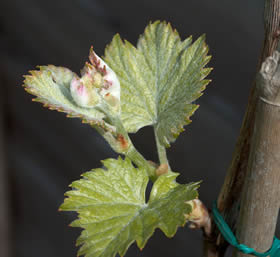 On
Friday afternoon we picked the boys up from school, went for our
favourite walk in Bushey park, and then had dinner at the
child-friendly Red Peppers restaurant in Teddington. On Saturday
morning, we surprised the boys with two new long-eared additions to
the family: a pair of rather fetching rabbits. I spent the rest of the
morning building a run (they came with a hutch), and the boys had
great fun taking them for walks round the garden on a special rabbit
lead. On
Friday afternoon we picked the boys up from school, went for our
favourite walk in Bushey park, and then had dinner at the
child-friendly Red Peppers restaurant in Teddington. On Saturday
morning, we surprised the boys with two new long-eared additions to
the family: a pair of rather fetching rabbits. I spent the rest of the
morning building a run (they came with a hutch), and the boys had
great fun taking them for walks round the garden on a special rabbit
lead.
Apart from this, weíve pretty much spent the weekend
having fun in the garden. How wholesome! Iíve been repotting and
sorting out some grape vines, and sowing a patch of lawn at the back.
The vines that have been planted in the garden are now getting up to
full steam. My raspberries and strawberries are also beginning to take
off. Echoes of The Good Life.
Vinous diversions have been many. I was so impressed
with one of the Nicolas Les Petites Rťcoltes wines that I
tried, I ordered a couple of cases (a mix of four six packs). These
are brilliantly packaged cheap Vin de Pays, very well made, and sealed
with either a screwcap or a Nomacorc synthetic. More about these
cheapies some other time. I also tried the 2004 Macualan Dindarello
from the Veneto, which is a very fresh, pretty sweet Muscat (Oddbins
£7.89/half). Itís nice and enjoyable, but not quite as good as I
remember a previous encounter to be. La Vigne Mythique 1999 is
a very stylish new wave Gaillac wine from Domaine DíEscausses.
It has plenty of that rather striking bloody, minerally, gravelly red
fruit that is typical of the Southwest of France, fused with some
softness and elegance from new oak. Itís therefore a tamer, rather
upmarket version of Gaillac. I enjoy the real, slightly raw thing
more. Another wine from the fantastic Caves des Pyrene. Tonight, Iím
on a very classy St Emilion, Ch Louvie 2002. This is a
perfectly balanced Bordeaux that Iím enjoying a good deal. Modern
and fruity, but still retaining that spicy, minerally core to the
fruit, and the acidity. From Cadman Fine Wines.
Some good news, too. Iíve been shortlisted for the Louis
Roederer International Wine Writer 2005 award, in category A
(Articles). This is very exciting, given the calibre of the other
nominees and the judging panel. I think we get some cash if we win,
plus a lot of Roederer Cristal, which would really impress all my
gangsta and premiership footballer friends.
Thursday
28th April
Last night got home fairly late and polished off the
remnants of a bottle of Galets Rouge 2000, a CostiŤres du NÓmes I
bought for around £4 just before Christmas. Itís a fantastic wine:
dense, earthy and spicy with the concentration and structure of a wine
costing at least three times this much. Not too refined, but I just
love the olive, herb and meat dimension this wine has Ė itís a
cross between a traditional Northern RhŰne wine and something bold
from the Languedoc. Itís not been made in the ubiquitous
sweet-fruit-to-the-fore style that is currently so popular. Not that
Iím against fruit. Fruit is good. But you need more than just fruit.
Wines need to be savoury and have some non-fruit complexity, or we may
as well give up and just drink fruit juice, with a dash of alcohol
added for its intoxicating properties.
Is fast food evil? Do I go to hell if I eat McDonalds
for breakfast, Burger king for lunch and sup at Pizza Hut? Tonight is
the first screening on UK television of Supersize me, a
documentary based around a journalists attempts to survive a month on
a fast-food-only diet. I shall watch it with interest, although I'm
expecting a reasonable dose of pseudoscientific nonsense when it comes
to some of the health issues discussed. Getting the 10.30 pm train
home last night I sat myself down and started reading, only to be
interrupted by a large (professionals Ė reading FT) couple who had
decided to snack on burgers and fries on their journey home. I felt
like addressing them on two counts. (1) Itís really antisocial to
eat smelly fast food on a crowded train. (2) They evidently didnít
need any more feeding up (weight: closer to 20 stone each than 10).
That they were Americans is incidental.
Iím not an anti-fast-food fascist though. I believe
it is possible to be healthy and eat fast food on a regular basis. You
could even survive quite adequately eating nothing more than
McDonalds. I know this sounds like heresy; let me explain my
reasoning. Our bodies are pretty flexible. Give them certain basics
(such as vitamins, trace elements, sufficient calories and some
protein) and weíll do OK. The problem with fast food is that it is
very high in fat and calories. Itís really difficult to not
over-consume in a fast food restaurant, simply because our bodies are
fooled by the high fat/calorie content of the food. Our metabolic
systems werenít designed to deal with this sort of food; normally
they are pretty good at regulating our intake (bear in mind that even
a small net daily over- or under-consumption would have severe
implications over the span of several years). Thus when we think
weíve had enough, weíve usually had far too much. Itís the net
consumption that is problematic: I wonder whether a thin person
surviving on McDs would have any health problems at all. It takes
almost superhuman self control to eat healthy portions in fast food
joints, and I have an inkling that this is the crux of the problem,
although I wouldnít be surprised if blood lipid profiles would take
a turn for the worse.
Added
later - while watching the program. I guess the medics at the
beginning had the same thoughts as I did. I'm about 50 minutes into
the film now, and while it is evidently a documentary with a strong
agenda, it's well made. It is very funny, too. It's important that we
think about what we eat and drink. It's difficult to know where to
draw the line, though, between thinking about what we eat and not
passing judgment on those with different tastes or social backgrounds
to us. Very important point currently being made in the film about
advertising: who advertises healthy food choices? 'You can't argue
that people should practice individual responsibility and then not
give them the information to do this', someone suggests in the
program. So far Morgan Spurlock has gained 17 pounds in 12 days. Back
to wine, who's advertising real wine as opposed to just branded or
mass production stuff? People buy what is available to buy, and for
most people, they get to choose from a selection of branded
wines...
Tuesday
26th April
I'm delighted to have won my first
wine writing prize, although it wasn't one I was expecting. I got
an email a few months ago saying that one of my articles which had
appeared in Singapore Tatler had made it to the finals of the 'World
Gourmet Summit' awards ceremony. This came out of the blue. Apparently
my trophy and certificate will be dispatched in May. No cash prize,
alas!
Very
interesting evening yesterday. It was dinner at St
John to showcase the Italian portfolio of Les
Caves de Pyrene, one of my favourite importers. The wines were
great, as was the food. Starters - piles of Langoustines with aoili.
Then it was suckling pig. Fantastic.
I
began the day in the same neck of the woods at the Barbican, observing
the International Wine Challenge faults clinic being set up. It should
yield some interesting data. While I was there, Wine International's
Sam Caporn gave me a generous gift of a bottle of 2000 Lynch Bages for
some rather trivial help I'd given her in her exam revision.
Completely beyond the call of duty to repay me this way, but I was
touched.
Sunday
24th April
Tasting the RhŰne: north and south
Some interesting bottles this weekend, with a RhŰne theme. On
Friday night I compared north and south. Two lovely wines, both
totally different, and for me encapsulating the significant
differences between these two regions which are often bundled rather
awkwardly together.
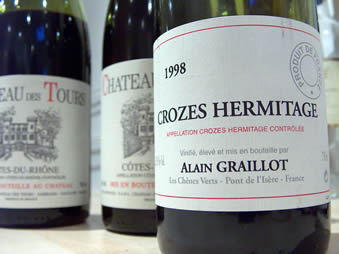 Alain
Graillot Crozes Hermitage 1998 Alain
Graillot Crozes Hermitage 1998
My last bottle of nine, I think, which have provided satisfying
drinking over the last few years. I love this wine: itís quite
extreme, but captures what I love about Northern RhŰne Syrah.
Distintive, pungent green-herbal and olive nose with some meatiness to
the fresh raspberry fruit. Still quite fresh and primary but with a
lovely spiciness. High-acid palate with a striking tartness to the
clean fruit. Challenging. Very good/excellent 91/100
Ch‚teau
des Tours CŰtes du RhŰne Reservť 2000
A shifting target: moving, alive, unpredictable and complex. Nose
of herbs, sweet berry fruit, exotic spices, undergrowth, tea leaves
and tobacco. The palate is sweetly fruitd with a seamless texture and
a distinctive character of Autumnal leaves. The overall impression is
one of sweetness. This is a profound wine Ė a bit on the edge, but
all the better for it. Itís living and breathing. In fact, itís
almost Burgundian Ė well Grenache is the Pinot Noir of the south.
The last of my six bottles. Very good/excellent 93/100
Both wines are completely different, yet share a common
theme: authenticity. And the fact that they are immediate in their
appeal, I guess. Beginners and perhaps also wine show judges would
dismiss both, because they arenít accessible and they could be
described as faulty, although this depends on your view about wine
faults (an article in itself). They both have a power to thrill and
excite that technically perfect wines lack.
On Saturday, I tried the 2001 of the last wine.
Ch‚teau
des Tours CŰtes du RhŰne Reservť 2001
Pale-ish, slightly faded colour. Itís savoury, earthy and herbal
with less sweetness than the 2000 vintage. Quite complex and balanced,
but lacks the added dimensions of its predecessor. Very good+ 88/100
Then tonight, shifting continents to try a cheap
Australian Grenache.
Peter Lehmann Grenache 2002 Barossa
This screwcapped wine is currently selling for £3.49 in Tesco
(special discount on all Australian wines). Quite a pale colour (not a
bad thing for Grenache) it has an inviting nose of sweet raspberry and
strawberry fruit with some appealing notes of spice, herbs and cured
ham. The palate is sweetly fruited with nice balance between the
sweetness of the fruit and the spicy, herbal structure. Not too
complex, but a very agreeable, authentic Grenache. Fantastic bargain
at that price. Very good+ 86/100
Tonight Iíve been working on a Harpers article on
screwcaps and whether oxygen is needed for the ageing of red wines.
Itís a really important issue, and after receiving comments from a
variety of experts on my first draft Ė including a 30 minute
conversation with Jeffrey Grossett this morning Ė Iím now happy
that it shows good balance. Itís important for journalists like me
to realize that in a piece everything you say can be true, yet the
piece can be unbalanced. ĎFactsí to journalists are no more than
bricks are to builders. Itís the way you put them together that
matters. I take my job as a wine journo seriously, and Iím always
willing to learn and be told that Iíve got things wrong, if I have.
Tomorrow morning, off to the Barbican to visit the International Wine
Challenge to look at how the faults clinic is set up - I'm writing a
piece on the results.
Monday
18th April
Went to see City play Fulham at Craven Cottage over the
weekend. Itís a nice ground to go to see football at, backing onto
the Thames and in easy walking distance of Putney Station. My last
visit was ages ago, back in 1999 I think, when City were in Division
Two and Andy Morrison got sent off for a tussle with Stan Collymore in
a 0Ė0 draw. Saturdayís game was a scrappy affair: City took the
lead and threatened to dominate, but then faded in the second half,
allowing Fulham to nick a point with a late equalizer. Man of the
match was Richard Dunne; itís slightly weird for a long-term City
fan like me to come to terms with the fact that weíve now got a side
that doesnít look horribly fragile at the back Ė the first time in
living memory. Star for the future? Joey Barton, the new Stevie
Gerrard.
I've long admired Luis Boa Morte, Fulham's Portuguese left winger: I
wonder why he's never been poached by a bigger club (sorry Fulham
fans). On Sunday, had a lovely afternoon with the kids in Kensington
Gardens, on a fresh, bright spring day full of hope and anticipation
for the summer ahead.
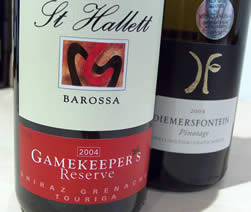 Weekend wines? Iíve been drinking Manzanilla and two
ripe, accessible reds. The Gonzalez-Byas Manzanilla that Tesco
are selling is brilliant stuff, and itís remarkably food friendly. I
tried it with Grana Padano cheese, and it worked fantastically. It
also worked well with a chinese stir-fry. Manzanilla is very similar
to Fino sherry; if anything itís a little lighter and fresher, but I
reckon Iíd be hard pressed to tell them apart tasted blind.
Versatile at table, but how many people treat their guests to a nice,
crisp sherry with their meals? People get worried by the alcohol
level, but this is 15%: itís not low, I agree, but itís probably
no higher than many new world reds, including the two in question
sipped this weekend. Weekend wines? Iíve been drinking Manzanilla and two
ripe, accessible reds. The Gonzalez-Byas Manzanilla that Tesco
are selling is brilliant stuff, and itís remarkably food friendly. I
tried it with Grana Padano cheese, and it worked fantastically. It
also worked well with a chinese stir-fry. Manzanilla is very similar
to Fino sherry; if anything itís a little lighter and fresher, but I
reckon Iíd be hard pressed to tell them apart tasted blind.
Versatile at table, but how many people treat their guests to a nice,
crisp sherry with their meals? People get worried by the alcohol
level, but this is 15%: itís not low, I agree, but itís probably
no higher than many new world reds, including the two in question
sipped this weekend.
These were just right for my mood. I wanted something
fun and unchallenging. First, the 2004 St Hallett Gamekeeperís
Reserve,
which shows vibrant raspberry fruit unobscured by oak and with just
enough spicy structure to keep it from becoming cloying. Then the Diemersfontein
Pinotage 2004, which is a strikingly modern take on this usually
funky grape dominated by ripe, roasted fruit. Both declared alcohol
levels in excess of 14%, and while I liked them a lot, I couldnít
help feeling they might be a bit better with less. The former is
currently under a fiver at Waitrose and a great bargain (Majestic also
carry it); the latter £6.99 at both Waitrose and Asda.
Not
playing football tonight alas, because of the long-standing hamstring
injury which is taking ages to heal.
Thursday
14th April
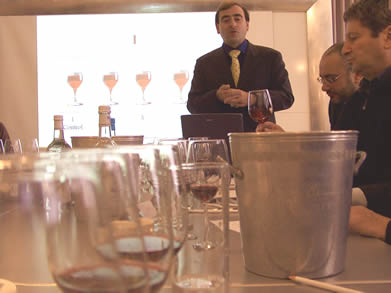 Today's faults clinic, sponsored by Amorim, was
an interesting event. Held at the ultramodern Sanderson Hotel on
Bernerís Street (aside: one of the most overtly stylish hotels
Iíve seen Ė the lifts alone are unbelievable), it was conducted by
famous wine scientist Pascal Chatonnet. Just over a dozen wine trade
people and a girl who does recipes for Elle (who must have found this
fabulously irrelevant to her magazineÖ) turned out and were treated
to a succession of spiked wines (the same red wine was used
throughout). The first three were various levels of TCA
(2,4,6-trichloroanisole; 3, 6 and 12
nanograms per litre, all smelt musty). Then we had TBA (tribromoanisole)
and TeCA (tetrachloroanisole), other
musty taint compounds not found in wine, but which can contaminate
wine in the winery environment. Next up, MDMP
(2-methoxy-3,5-dimethylpyrazine),
a newly discovered taint compound found in corks Ė Pascal pointed
out we were among the first in the world to try wines spiked with
this. Itís not nice. Some industry people reckon itís second only
to TCA as a taint compound; others disagree; we donít yet have good
data on this. Then we tried 2-isobutyl-3-methoxypyrazine, the famous
grassy/vegetal compound that some naughty South Africans have
supplemented their Sauvignon Blancs with, and which occurs naturally
in unripe grapes. Volatile phenols were next: we tried a wine spiked
with 2000 micrograms/litre of a 10:1 mix of 4-ethylphenol and
4-ethylguiacol. This is to simulate a brett infection, but the spiked
wine wasnít quite the same as the bretty wines Iíve come across
before, tasting very medicinal and phenolic but without of the
animally character. Pascal emphasized that above-threshold levels of
these molecules cause by brett are a lot more common than people
realize. Finally, we tried two wines with additions of ethyl acetate
and acetic acid. These were simulating volatile acidity. Today's faults clinic, sponsored by Amorim, was
an interesting event. Held at the ultramodern Sanderson Hotel on
Bernerís Street (aside: one of the most overtly stylish hotels
Iíve seen Ė the lifts alone are unbelievable), it was conducted by
famous wine scientist Pascal Chatonnet. Just over a dozen wine trade
people and a girl who does recipes for Elle (who must have found this
fabulously irrelevant to her magazineÖ) turned out and were treated
to a succession of spiked wines (the same red wine was used
throughout). The first three were various levels of TCA
(2,4,6-trichloroanisole; 3, 6 and 12
nanograms per litre, all smelt musty). Then we had TBA (tribromoanisole)
and TeCA (tetrachloroanisole), other
musty taint compounds not found in wine, but which can contaminate
wine in the winery environment. Next up, MDMP
(2-methoxy-3,5-dimethylpyrazine),
a newly discovered taint compound found in corks Ė Pascal pointed
out we were among the first in the world to try wines spiked with
this. Itís not nice. Some industry people reckon itís second only
to TCA as a taint compound; others disagree; we donít yet have good
data on this. Then we tried 2-isobutyl-3-methoxypyrazine, the famous
grassy/vegetal compound that some naughty South Africans have
supplemented their Sauvignon Blancs with, and which occurs naturally
in unripe grapes. Volatile phenols were next: we tried a wine spiked
with 2000 micrograms/litre of a 10:1 mix of 4-ethylphenol and
4-ethylguiacol. This is to simulate a brett infection, but the spiked
wine wasnít quite the same as the bretty wines Iíve come across
before, tasting very medicinal and phenolic but without of the
animally character. Pascal emphasized that above-threshold levels of
these molecules cause by brett are a lot more common than people
realize. Finally, we tried two wines with additions of ethyl acetate
and acetic acid. These were simulating volatile acidity.
Why did Amorim sponsor this? Clearly, the message
theyíd like people to take away is that not all wine problems are
caused by the cork, which gets blamed perhaps more than it should.
Still, the acid test of whether environmental contamination by musty
wine is a big problem in practice should be whether we see many musty
wines that are sealed by screwcaps and plastic corks. If we see, say
0.5% of alternatively sealed bottles exhibiting mustiness, then we
could conclude that 0.5% of taint incidences in cork-sealed bottles
are likely to be environmental, also.
Stuart
Peskett (of Harpers) and I stayed behind for a lunch with Carlos,
Pascal and PR person Lyney, at which we drunk Dirk Niepoort's 2001
Redoma Rosť - thank goodness this didn't have any faults
(although Pascal did break the corkscrew on his first attempt to open
it).
Wednesday
13th April
 Last night met up with Amorimís PR chief Carlos de
Jesus (right) at a nice but rather overpriced Japanese restaurant (my fault
for choosing us, but they stiffed us royally on the billÖhow do five
Asahis and a bottle of sparkling water come to £33?). Carlos has been
heading up Amorimís PR for a couple of years now, a job that must
have seemed a bit of a poisoned chalice when he took it on. Indeed,
you wonder what would have made a high flying consultant like Carlos
who has worked around the globe take on this sort of job Ė perhaps
he didnít know much about the wine trade and more specifically the
closures debate. Or perhaps he was offered gold. Lots of it. Anyway,
Carlos is now buzzing, because the tide seems to have turned very much
in favour of natural cork in recent months Ė or should I say, the
future for cork now looks a little less bleak than it did last year.
Why? Because screwcaps are running into problems. Just how big isn't
clear yet. As they are becoming more popular, itís now the screwcap
advocates who are back tracking in the face of reduction problems.
[Not time to explain fully here, but Ďreductioní refers to the
production of volatile sulfur compounds in the reductive conditions
created by the very tight seal of a tin-lined screwcap.] The latest
line, from Huon Hooke, is that yes, there may be some reduction
problems with screwcaps, but the consumer wonít notice them. And
others suggest that reduction problems are a winemaking issue:
producers need to change their winemaking techniques to suit screwcaps
Ė that is, if the slipper doesnít fit, change the foot. [Hello? Is
anyone home?] What is becoming clear is that closures are different,
and winemakers need to see winemaking as continuing post-bottling.
Closure choice is important. And in the absence of a complete
understanding of post-bottling wine chemistry (a subject where
knowledge is incomplete but advancing rapidly), youíre probably best
off for now sticking with a closure whose performance, while not
completely satisfactory, is at least well known. So in the next few
months, at least, Carlosí job looks a lot easier. But if I were him,
I might start making plans to move on in a couple of yearsí time! Last night met up with Amorimís PR chief Carlos de
Jesus (right) at a nice but rather overpriced Japanese restaurant (my fault
for choosing us, but they stiffed us royally on the billÖhow do five
Asahis and a bottle of sparkling water come to £33?). Carlos has been
heading up Amorimís PR for a couple of years now, a job that must
have seemed a bit of a poisoned chalice when he took it on. Indeed,
you wonder what would have made a high flying consultant like Carlos
who has worked around the globe take on this sort of job Ė perhaps
he didnít know much about the wine trade and more specifically the
closures debate. Or perhaps he was offered gold. Lots of it. Anyway,
Carlos is now buzzing, because the tide seems to have turned very much
in favour of natural cork in recent months Ė or should I say, the
future for cork now looks a little less bleak than it did last year.
Why? Because screwcaps are running into problems. Just how big isn't
clear yet. As they are becoming more popular, itís now the screwcap
advocates who are back tracking in the face of reduction problems.
[Not time to explain fully here, but Ďreductioní refers to the
production of volatile sulfur compounds in the reductive conditions
created by the very tight seal of a tin-lined screwcap.] The latest
line, from Huon Hooke, is that yes, there may be some reduction
problems with screwcaps, but the consumer wonít notice them. And
others suggest that reduction problems are a winemaking issue:
producers need to change their winemaking techniques to suit screwcaps
Ė that is, if the slipper doesnít fit, change the foot. [Hello? Is
anyone home?] What is becoming clear is that closures are different,
and winemakers need to see winemaking as continuing post-bottling.
Closure choice is important. And in the absence of a complete
understanding of post-bottling wine chemistry (a subject where
knowledge is incomplete but advancing rapidly), youíre probably best
off for now sticking with a closure whose performance, while not
completely satisfactory, is at least well known. So in the next few
months, at least, Carlosí job looks a lot easier. But if I were him,
I might start making plans to move on in a couple of yearsí time!
We also discussed the consolidation of the wine market
and the power of multiples like Tesco. Carlos is convinced that
further consolidation is inevitable. If Tesco cut their wine range, as
they are rumoured to be planning, then given
their powerful position itís going to be very bad news for the UK
market indeed. We have a situation where there is the fine wine market
(niche) that is quite healthy, but then there is this chasm that
separates this from to sorts of wines that normal people buy and
drink, where wine is more-or-less a commodity and is marketed on price
alone. The middle ground in wine retailing (as in other forms of
retailing) is on the decline. In fact, itís vanishing. The
implications for consumer wine journalists are obvious. Youíre out
of a job, mate.
Sunday
10th April
Itís been another fine weekend, with some nice
surprises on the wine front. Friday night we enjoyed a simple meal:
some rustic bread, parma ham and two cheeses Ė Grana Padano and
Provolone. To match this, a wine that worked almost perfectly, the Cuvťe
des Fees Minervois 2003 from Laurent Miquel (£6.99
Waitrose, on offer at £5.59). Itís a Languedoc Syrah possessing
that perfect blend of modern, ripe fruit and some spicy, tannic
structure. Very satisfying. I began the evening browsing through
Andrew Jeffordís brilliantly written book on Islay, Peat, Smoke and
Spirit (I shall hunt out a bottle of Islay to read the rest with), and
ended it watching the Masters Ė the first Major tournament of the
year, and one that I watch every year as a semi-tradition. Golf is a
funny sport and I understand why many people have a problem with it,
but I love being out on the course. I used to play a fair bit but
Iíve tamed by addiction, and havenít played for ages. I hate to
think what Iíd score at Augusta National Ė the best course Iíve
yet played is Sunningdale and I found that tough yet enjoyable going.
Saturday night had a nice surprise. A cheap white Vin
de Pays díAigue 2004 from usually overpriced chain Nicolas. This
is a screwcapped cheapie (£3.99) but itís really nice: lemony fresh
with some herby, grassy fruit and none of the confected aromatic yeast
character that spoils a lot of cheap modern whites. This white is from
a co-op in Beziers. If the French can make good cheap whites like this
and package them so attractively, they havenít got too much to fear
from the new world. Sadly, they often canít. Spent early evening
working on some Oxford Companion entries, then Match of the Day
provided the late-evening viewing where it was particularly delicious
to see City beat Liverpool and Man UTD lose to Norwich. Regarding
Norwich, I just donít understand why they play this really annoying
music over the PA system when they score a goal. This must be the
defining sign of a loser club: the fans donít cheer enough, so they
need music to raise the atmosphere with each goal.
Tonight Iím on the remains of the Grana Padano,
washed down with a rather beefy Amarone, watching the final stages of
the Masters again. Woods looks like heís going to walk it, although
heís just lost a shot on the 10th. A nice little duel is developing
with Chris di Marco, though, so weíll have to see.
Friday
8th April
Early yesterday evening went to meet the rest of the
family in Regentís Park Ė theyíd been to the zoo for the day.
But we got caught in a snap thunderstorm that included the largest
hailstones Iíve ever seen. OK, they werenít Day After Tomorrow
crush-your-skull size, but they hurt. Hail is one of the biggest
calamities that winegrowers have to contend with: in just 10 minutes
an entire vintage can be ruined. After yesterdayís experience I can
now understand how devastating hail can be to a vineyard. Even if just
a portion of grapes are damaged, this can lead to subsequent bunch
rot, and a harvest with just a proportion of rotten grapes can
severely diminish quality. Added to this, damaged foliage can reduce
the ability of the vine to ripen grapes properly.
We had dinner at Pizza Express at the Langham Place end
of Regent Street. I was quite impressed, especially by the mark-ups on
the wine list. We had the 2003 Anselmi San Vicenzo (a modern,
full flavoured IGT Veneto white from Soave vineyards) which was
delicious, and at £14.55 was less than double the usual shelf price
Ė for London, this shows admirable restraint.
Monday
4th April
Iím very excited about a piece that I have in issue 6 of The
World of Fine Wine, which will be coming out in a couple of weeks.
Itís a mammoth 6000 word effort on wine and the brain, examining how
our perception of wine is constructed in the brain. There arenít
many magazines that will address such a lofty subject Ė and even
fewer who will give writers several thousand words to play with.
The nature of our perception of wine is a subject that
Iím increasingly being drawn towards. Iím also acutely aware that
I lack the in-depth training in philosophy, psychology and neuroscience
that would better equip me to address the rather deep questions that are
raised by the practice of wine tasting. These are too numerous to
address in the context of a blog entry, but Iíll just feed you a
taster of a thought.
Think about your internal mental state right now. It is
shaped not only by the environmental stimuli you are attending to, but
also by input from your own thoughts and memories. Our choice of what
we pay attention to shapes the environmental cues we receive. Most of the
time we arenít aware, for example, of what our big toe is doing. But
if we choose to move it, we become aware of it. If two people enter
the same library, they will both have a different experience of that
library dependent on which shelves they visit and which books they
choose to browse. With a glass of wine,
I can choose to slug it back, or I can choose to put it under sensory
scrutiny. However, if I take this second course of action, what I find
will depend to a degree on what I am looking for. How is the acidity?
What is the structure like? Is there any oak influence? Where does it
come from? How we make the decisions about which elements of the
wine to focus on is a complex question. For someone who has just read
an article on brett, a hint of spicy, animally character is likely to
have different significance (and thus be a more dominant feature) than
for someone who doesn't know what brett is. There are many similar
examples of attention shaping our experience.
It is likely that the way we approach wine tasting is
by a process of first deciding what sort or type of wine we are
dealing with, and then treating it along the lines this initial
classification leads us. (Using posh language, our Ďrepresentations
are prototypicalí). So we come across a white wine blind. Our first
thought is to wonder what sort of wine it is. Say we decide it is a
Sauvignon Blanc. Then we think of the sorts of descriptive terms
typically associated with Sauvignon, and marshal these in the service
of describing the wine. Often we arenít tasting blind; then we use
the information we already have to guide our descriptive endeavour. It
sounds a bit phony, but most of the time it works, even though we
donít realise what we are doing at the time.
Playing
football again tonight. Let's hope the bad example from the weekend's
premiership - where two players from the same side got sent off for
fighting each other - doesn't affect our game!
Sunday
3rd April
 An
almost perfect weekend here in this corner of west London. On Saturday
we began with some decorating - rather bizarrely, you might think, we
paid two teenagers (kids of friends) to come and spray-paint one of
our son's bedroom walls. He's now got his name written in metre-high
graffiti lettering. It's what he wanted. Then we wet off for a picnic
to Kew Gardens, where we had one of those near-perfect days that come
around all too infrequently. We lunched with two screwcapped quarter
bottles of wine. Mine was a red, a Kumala Pinotage Shiraz 2004.
Normally, this sort of wine would be of limited appeal, but on
Saturday, lying on the grass in the sun, it was close to perfect. A
rustic Pinotage tang complemented vibrant, juicy berry fruits - just
right for the context. This was drunk from an ISO glass, which is the
most robust and compact item of stemware I possess. Back home, some
more decorating and a bit of work in the garden. Then today we went
over to see my folks who were babysitting my sister's kids in Gerrards
Cross. With lunch a bottle of Falesco Vitiano 2002 from Umbria that
was lying in the 'to drink' rack. 2002 may not be a great vintage, but
this was delicious. Noticeably Italian, with its tarry, spicy, earthy
fruit, but in quite a modern perfumed style. The kids played happily
in the garden on a trampoline, and we had a game of football.
Fantastic. An
almost perfect weekend here in this corner of west London. On Saturday
we began with some decorating - rather bizarrely, you might think, we
paid two teenagers (kids of friends) to come and spray-paint one of
our son's bedroom walls. He's now got his name written in metre-high
graffiti lettering. It's what he wanted. Then we wet off for a picnic
to Kew Gardens, where we had one of those near-perfect days that come
around all too infrequently. We lunched with two screwcapped quarter
bottles of wine. Mine was a red, a Kumala Pinotage Shiraz 2004.
Normally, this sort of wine would be of limited appeal, but on
Saturday, lying on the grass in the sun, it was close to perfect. A
rustic Pinotage tang complemented vibrant, juicy berry fruits - just
right for the context. This was drunk from an ISO glass, which is the
most robust and compact item of stemware I possess. Back home, some
more decorating and a bit of work in the garden. Then today we went
over to see my folks who were babysitting my sister's kids in Gerrards
Cross. With lunch a bottle of Falesco Vitiano 2002 from Umbria that
was lying in the 'to drink' rack. 2002 may not be a great vintage, but
this was delicious. Noticeably Italian, with its tarry, spicy, earthy
fruit, but in quite a modern perfumed style. The kids played happily
in the garden on a trampoline, and we had a game of football.
Fantastic.
Wednesday
30th March
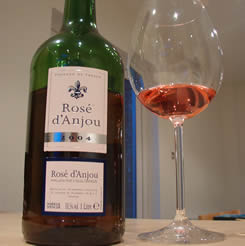 Sticking with the Loire, but going from a pale red to a true
rosť. Last night's offering was one of those wines I couldn't make my
mind up about. The M & S Rosť d'Anjou 2004, sent to me by
Sopexa as an unsolicited sample, is perhaps the least attractively
packaged wine I've tried in a while: it comes in a cheap-looking litre
bottle with a screwcap without a skirt - it looks like what the
Americans describe as a 'bum wine'. A pale reddish pink colour, it has
a modern nose of boiled sweets, with some sweet strawberry fruit. The
palate is like a fruit cordial - off dry with sweet redcurrant and
strawberry flavours. No rough edges and dangerously easy to drink.
Should I hate this wine, or should I applaud it for its modern
drinkability? Refreshingly, only 10.5% alcohol. Try some, very well
chilled, on a summer's afternoon, from a jug. Sticking with the Loire, but going from a pale red to a true
rosť. Last night's offering was one of those wines I couldn't make my
mind up about. The M & S Rosť d'Anjou 2004, sent to me by
Sopexa as an unsolicited sample, is perhaps the least attractively
packaged wine I've tried in a while: it comes in a cheap-looking litre
bottle with a screwcap without a skirt - it looks like what the
Americans describe as a 'bum wine'. A pale reddish pink colour, it has
a modern nose of boiled sweets, with some sweet strawberry fruit. The
palate is like a fruit cordial - off dry with sweet redcurrant and
strawberry flavours. No rough edges and dangerously easy to drink.
Should I hate this wine, or should I applaud it for its modern
drinkability? Refreshingly, only 10.5% alcohol. Try some, very well
chilled, on a summer's afternoon, from a jug.
Sunday
27th March
Jean Teillerís 2001 Menetou-Salon Rouge is
something a bit different. Itís a fresh red wine, only a little
darker than a rosť. Thereís a dominant, savoury leafy/herbal
character to the nose, along with some rather soft cherry and plum
fruit on the palate. Good acidity. Not a particularly great wine, but
a good, sappy effort thatís a sort of halfway house between red and
white. The winemaker has been faced with barely ripe Pinot Noir
grapes, and she (or he) has taken the wise decision not to overextract,
which would have resulted in a darker, but harsher and greener wine. I
like it, but it needs food or a sunny day to sustain interest. Part of
the value of a wine like this is that it is so distinctive. Itís
like a note on the piano that you donít use very much, but which
would be missed if it was absent. Diversity is important, and in the
wine world it should be cherished. By all means make wine less
complicated and bemusing for novices, but letís do all we can to
ensure the survival Ė and even development Ė of wine diversity.
Watching some inane, nonsense telly tonight, and caught
a snippet of a reality program tracking the work of the staff at
Windsor Castle. They showed the wine waiters preparing for a state
dinner with president Chirac. To start with guests were given Pol
Roger NV Champagne, which was followed by a Chassagne Montrachet (no
further details given, although from a glimpse of the label it looked
like a premier cru, grower unknown). The claret was Leoville Poyferre
1990, and with dessert the rather odd choice of Krug 1982. The real
tragedy was the glassware these wines were served in: vintage crystal
glasses of entirely the wrong shape. They should get the experts in to
select the wines and serve them. I could choose better wines (although
I was reasonably impressed with the fizz they served), I suspect, and
Iíd make sure they were enjoying them out of suitable Riedel
glasses.
Saturday
26th March
It's been a fabulous Easter weekend do far. Three days of hard but
very enjoyable labour have cleared the final quarter of our garden
(pictured below in July 2004 on left, taken from my study window,
today on right). When we moved in we found that the previous owners
had used this as a rubbish tip to the extent that the level was about
three feet higher than the rest. We got a guy with a digger in to
shift the muck into various piles and to level everything off, but it
has taken a while to get things clearer. We also had our first
barbecue of the year at lunchtime. Fantastic. To drink, an old friend
in a new vintage: the Torres Vina Sol 2004. It's the ideal cheap white
wine. It hasn't been tarted up with a bit of oak or some residual
sugar, like so many at this price point. What you get is a fresh,
vibrant dry white wine, with the fruit tending towards lemon and (only
just ripe) honeydew melon with an acidic tang. A brilliant situation
wine with a crisp personality and well matched to a variety of
foods.
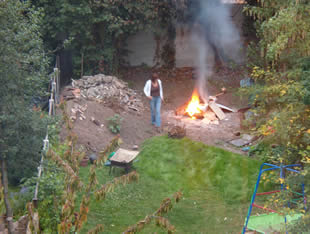 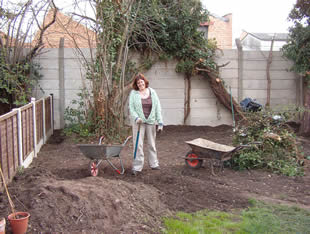
Thursday
24th March
Today was the Wine
International 10 years on tasting. A brilliant idea: get together
expert tasters (like myself...) and assess how the wines from the
vintage a decade earlier are doing. So this year, it's 1995. Too many
wines for one person to taste all, so we are grouped into teams. I was
lucky to be paired with two of my favourite people in the wine trade -
Sam Harrop MW and Peter Richards. We tasted Shiraz and RhŰne blends,
and new world reds. It's a fascinating experience to taste completely
blind, where reputations count for nothing. I'll have more to say
about this later, but when I got the crib sheet it gave me plenty of
food for thought. Some pretty serious wines didn't show that well at
all... Also, a lot of brett evident. More details will have to wait: I
relaxing this evening. Already stiff from Monday night's football
(I've started playing again after six months off), I've been busy
shifting several tons of rubble from our garden into a skip. It was a
family effort, but I know I'll be suffering tomorrow. Goodness, I
sound like an old bloke, and I'm not, really. Wine tonight: Porcupine
Ridge Sauvignon 2004 (a fantastic South African cheapie - the
Porcupine Ridge wines are hard to beat for the price, which is around
£6.49, Oddbins and Waitrose). Plus the remains of a rather
disappointing Primitiu de Bellemunt Priorat 2000, which tastes a bit
baked. Oh, and the last half of my last bottle of Castelnau de
Suidauraut 2000, a really fabulous inexpensive Sauternes.
Previous entries
Back to top
|